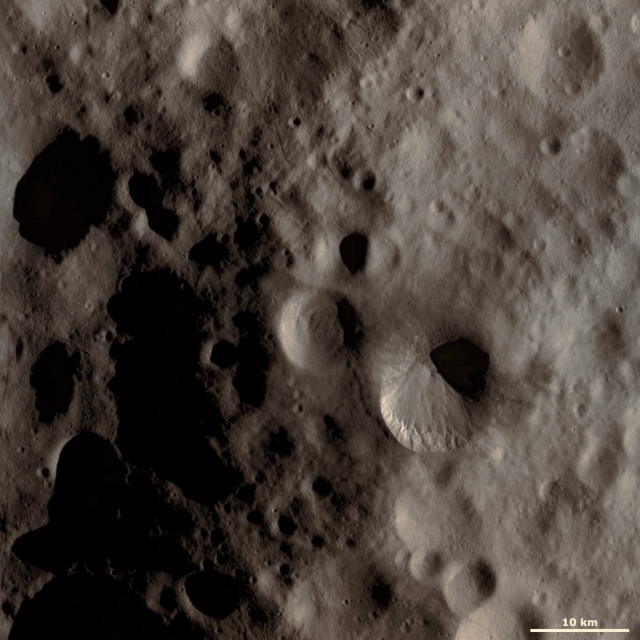
August 17, 2012
NASA/JPL-Caltech/UCLA/MPS/DLR/IDA and Dr Paolo C. Fienga per il process. addizionale e la colorizzazione
|
This Dawn Framing Camera (FC) image of the Giant Asteroid 4-Vesta shows Fabia Crater, which is the large Crater located at about 4 o'clock, offset to the bottom, slightly right of the center of the image. Fabia Crater is very distinctive because the two sides of its Rim have very different states of freshness. In this image, the Southern (bottom) part of the Rim is distinct and fresh, but the top part of it appears way more rounded and degraded. This dichotomy between the two different portions of the Rim is possibly due to the verification, on the Southern (lower) part of the Rim, of a phenomenon known as "Gravity Mass Wasting" (*) - meaning that a certain quantity of Rocks and Dust collapsed and, subsequently, slid all the way down, moving along the Southern Inner Slope of the Crater, towards its bottom part, where it finally rested -, while on the Northern (upper portion) of the Crater's Rim, a mixture of Rocks and Dust (---> often referred to as "Material") slumped over the top part of it, thus causing the Rim itself to become obscured (---> covered by the Material) and (apparently) more degraded. Note that on the Southern portion of the Crater, the Gravity Mass Wasting Event caused the formation of Linear Features (which are very well visible on the illuminated part of Fabia Crater), created by Material cascading towards the center of the Crater. There is also a distinguishing band of bright Material along the bottom Rim of Fabia Crater, whose origin and nature, however, are still unknown. This image shows a small portion of 4-Vesta's Numisia Quadrangle, located in the Asteroid's Northern Hemisphere. The NASA - Dawn Spacecraft obtained this image with its Framing Camera on Oct. 19, 2011. This image was taken through the Framing Camera's Clear Filter. The distance between the Spacecraft and the Surface of 4-Vesta was, at the time that this picture was taken, approx. 700 Km (such as about 435 miles); the image has a resolution of about 63 meters (207 feet) per pixel. This image was acquired during the H-AMO (---> High-Altitude Mapping Orbit) Phase of the Mission. (*) The Gravity Mass Wasting (also known as Slope Movement or Mass Movement), is the Geomorphic Process by which Soil, Sand, Regolith and Rock move downslope under the sole force of Gravity. Types of Gravity Mass Wasting include Creep, Slides, Flows, Topples and Falls, each with its own characteristic visible features; it is important to remember that the Gravity Mass Wasting may take place over timescales going from seconds to years. In other words: when the Gravitational Force acting on a given Slope exceeds its Resisting Force, then the "Slope Failure" (such as the "Mass Wasting Event") occurs. The frame has been colorized in Absolute Natural Colors (such as the colors that a normal - meaning "in average" - human eye would actually perceive if someone were onboard the NASA - Dawn Spacecraft and then looked down, towards the Surface of the Giant Asteroid 4-Vesta), by using an original technique created - and, in time, dramatically improved - by the Lunar Explorer Italia Team. |
News visualized: 655 times

